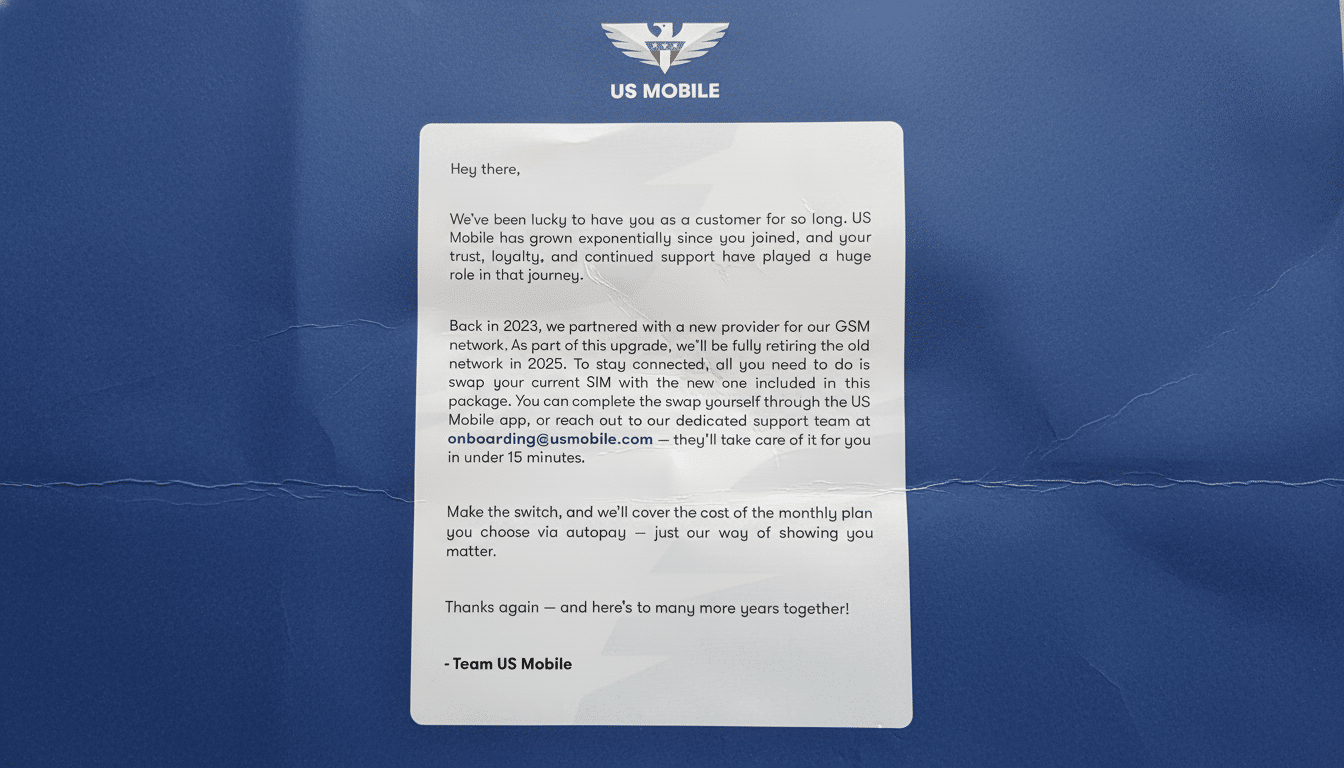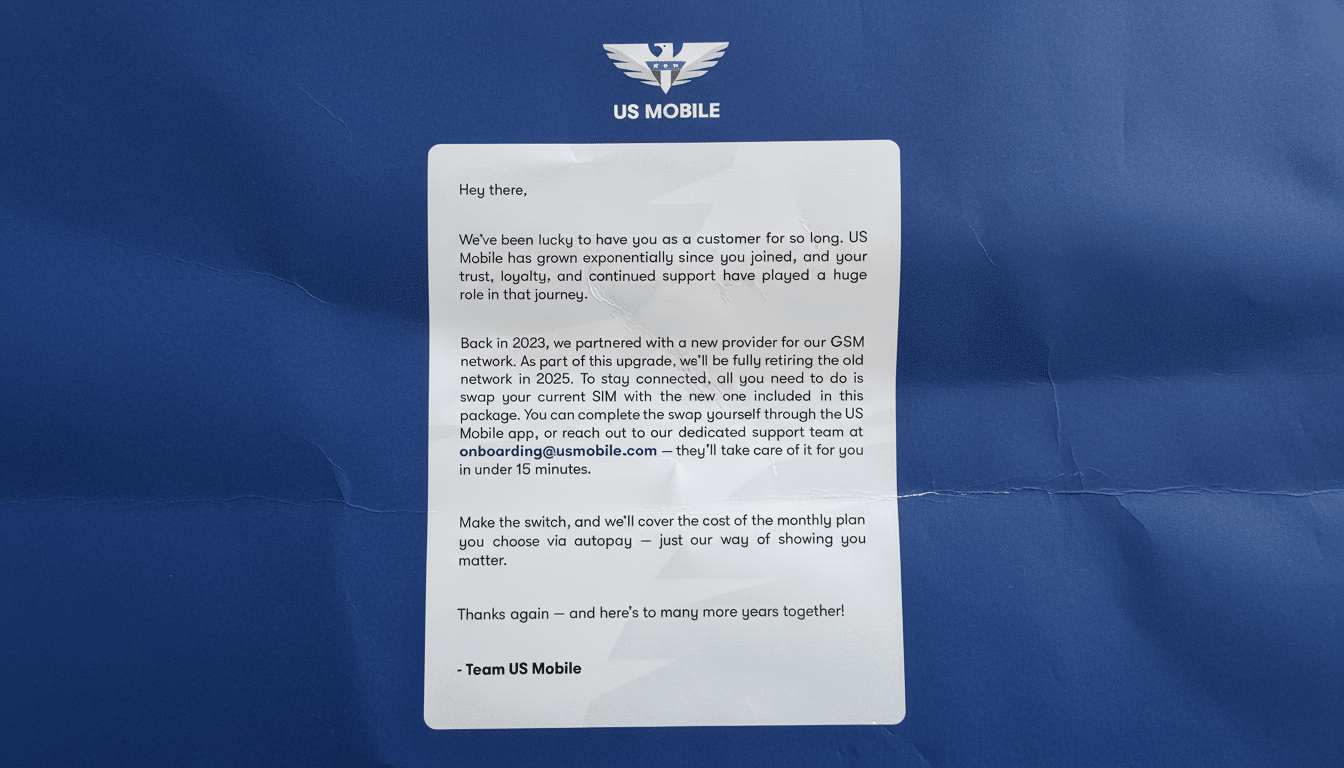US Mobile now bills itself as a “super carrier,” offering customers service on all three major U.S. networks — AT&T, T-Mobile, and Verizon — from one account.
Its premise is deceptively simple: Choose the best signal no matter where you are. In action, it’s a clever combination of multi-network tech, eSIM provisioning, and policy guardrails that decide on how you may (or may not) skip around between carriers.
- How Tri-Network Access Really Works at US Mobile
- On-Demand Switching Compared to Multi-Network Mode
- Limits, Fees, and Fair-Use Rules for Switching Networks
- Coverage Speed and Deprioritization Reality
- What You Need for a Smoother Experience with US Mobile
- Who US Mobile’s Tri-Network Service Is Best For
- Bottom Line on US Mobile’s Three-Network Flexibility

For travelers, for rural users, and for anyone who has squinted at one wretched bar in a packed stadium, the promise is plain. The devil is in the details, though — it all depends on your plan, your device and how urgently you need to make the switch.
How Tri-Network Access Really Works at US Mobile
US Mobile is a mobile virtual network operator (MVNO), which means it purchases wholesale access to networks from the big carriers and then resells this access in the form of SIM or eSIM profiles. Your line is configured with network settings (PLMN, APN and IMS voice profile) from a certain hosting network. Thanks to eSIM, US Mobile can send a new profile “over the air,” as it were, and theoretically “port” your line from one network to another — no physical card required.
You have two options for getting multi-network coverage: a plan that allows you to simultaneously access two networks and performs automatic hand-offs to the best network in the background, or an on-demand approach where you manually switch your line over to another carrier through the app. The former behaves most like Google Fi’s early multi-carrier model; the latter is more akin to a quick mini-port you can activate whenever you desire.
On-Demand Switching Compared to Multi-Network Mode
Multi-network mode is the best thing you’ll get to “seamless.” Your phone toggles between two carriers it supports, depending on signal strength and policy, which is helpful if one carrier fades indoors, in rural dead zones or during a local outage. Think road trips where AT&T covers miles of rural highway but Verizon rules the downtown core in the next town.
On-demand switching is more hands-on. You select a new network in the US Mobile app and the service reprovisions your line. You’ll need Wi-Fi for the process, and while US Mobile typically estimates around 15 minutes it takes to activate, real-world experiences differ — since most go through without a hitch, others may demand restarts or sometimes drag on into hours if there’s a hiccup at the backend. eSIM, for all its faults, makes that a whole lot smoother than managing physical SIMs.
Limits, Fees, and Fair-Use Rules for Switching Networks
To avoid a churn campaign, US Mobile has guardrails in place. Users are usually allowed to switch networks only once every three hours, with a maximum of eight switches per billing cycle. The first two switches are complimentary and additional transfers come with a small fee, though some of the highest-tier plans waive those charges. These limits won’t affect most travelers, but they discourage rapid-fire toggling in pursuit of those marginal speed gains.
Coverage Speed and Deprioritization Reality
Why even switch? Because each carrier excels in different areas. Fair and independent tests from Opensignal and Ookla show T-Mobile ahead in 5G availability and average speeds, while RootMetrics frequently highlights Verizon’s reliability and AT&T’s strong overall performance across metros. T-Mobile has publicly argued its 5G reaches 98% of Americans, and the industry group CTIA says that’s also how it sees the state of coverage by all carriers for 5G today — now covering virtually all Americans at a cost to carriers annually in tens of billions.

Nonetheless, MVNO traffic may be subject to deprioritization in times of congestion versus postpaid lines on the host network. That means just because you have a full signal doesn’t mean it will deliver peak throughput when thousands of other people are on the same cell. The ability to hop on a less-crowded network can be a game saver in stadiums, festivals or when an outage of a single carrier strikes.
What You Need for a Smoother Experience with US Mobile
eSIM is the key to easy switching. Most recent iPhones and Google Pixels, as well as newer Samsung Galaxy flagships, support eSIM; new iPhones launched in the U.S. are eSIM-only (no traditional SIM slot). Make sure to get an unlocked device that is able to connect to all three carriers with the right 5G bands — particularly mid-band 5G, which offers the biggest speed increases. VoLTE and Wi-Fi Calling would also remain on after each toggle, so calls and messaging act as they should.
If you’re on the multi-network plan, it’s more “it just works” behavior. If you rely on on-demand transfers, anticipate: find a friend with Wi-Fi, don’t use a switch one minute before needing to jump into a meeting, and be aware of your number of switches per month so the cost doesn’t take you by surprise.
Who US Mobile’s Tri-Network Service Is Best For
Frequent travelers, hybrid remote workers, students on the go and rural residents at coverage edges are going to be the sweetest spots for value. If you knock out a few new ZIP codes every month or regularly deal with stadium traffic jams, the ability to jump networks is a convenient step up from a one-carrier MVNO.
It’s more about peace of mind than day-to-day gains if you spend 95% of your time in an area with solid service, anyway.
And if you want zero-touch, always-on network blending, the US Mobile multi-network plan is the one to look at; manual switching is great, but it’s not magic.
Bottom Line on US Mobile’s Three-Network Flexibility
US Mobile’s tri-network coverage is the real deal, a compelling and usable service made available through MVNO agreements, eSIM provisioning and smart — if fairly rigorous — switching requirements. It’s not going to replace a multisocket enterprise multi-carrier router or a superconfigurable hotspot that you can program (oh yeah, no external API here), but for a phone plan, it is quite the rare and odd combination of flexibility with gentle user-friendliness in an industry where coverage uncertainty suddenly becomes an option instead of “Oh Lordy.”

